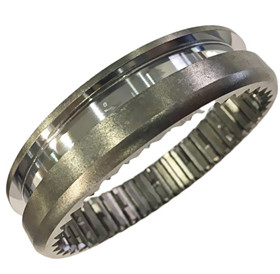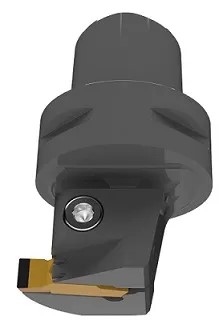
Synchronizer ring
The synchronizer is a component of the manual gearbox. Its function is to force the driving gear and the driven gear to have the same speed when the transmission is shifting, so that the two gears mesh together quickly to avoid noise and vibration and ensure the gearbox Smooth shifting. The synchronizer ring (combination sleeve) is connected with the shift fork to execute the movement transmitted by the shift handle.

The challenge you face
1.Improve production efficiency while reducing costs
2.Ensure product dimensional accuracy
Non-standard CBN turning tool
.jpg)
-The two sides of the synchronizer ring are processed by the plunge turning process, the cutting distance is significantly shortened, and the processing efficiency is significantly improved
-Use the entire cutting edge length of the CBN insert to cut, which improves the utilization of the cutting edge of the insert
-Two different cutting edges of the same tool tip are used to make full use of the cutting edge
-Stable quality of processed products
-Long work life
Case
Process both sides of a certain type of synchronizer ring groove, hardness HB680, surface finish requirement Rz 2.0
Blade: VBGW160404S-00515-TTL6B, CBN150
Processing parameters:
Vc=185 m/min,
Feed per tooth f=0.03 (cutting in)/0.05 (finishing turning);
Tool life: 1200 pieces/edge;
Non-standard MDT slot cutter

-The bottom surface of the synchronizer ring is processed by the plunge turning process, the cutting distance is significantly shortened, and the processing efficiency is significantly improved
-Use the entire cutting edge length of the CBN insert to cut, which improves the utilization of the cutting edge of the insert
-Stable quality of processed products
-Long work life
Case
Process the bottom surface of a certain type of synchronizer ring groove, hardness HB680, surface finish requirement Rz 8.0;
Blade: LCGN300804-0870S-01025-LF, CBN150
Processing parameters:
Vc=185 m/min,
Feed per tooth f=0.05;
Tool life: 2500 pieces/edge;
A technical guide to selecting diamond grinding wheels for PDC cutter . Learn how ceramic and resin bond diamond wheels improve efficiency, precision, and tool life in oil & gas and mining applications.
High-performance diamond composite cutters (PDC) for stone cutting saw blades. Learn key structural features, performance requirements, and selection guidelines for granite, marble, and quarry cutting applications.
Add: Zhongyuan Rd, Zhongyuan District, Zhengzhou, 450001, Henan, China
Tel: +86 17700605088